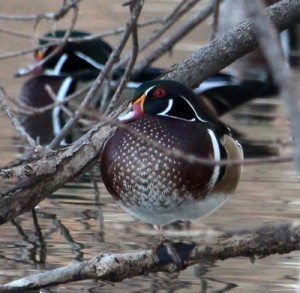by John Shackford

This year’s bird for a “Holiday Season Greeting Card” is the Wood Duck (Aix sponsa). Few duck species in the world rival the beauty of a male Wood Duck, and from birders to sportsmen, few ducks rival its popularity. The Wood Duck breeds over most of eastern North America, in a band across the top tier of U.S. states, and finally down the west coast. It only goes into Canada in a relatively few areas, almost as if it were shunning Canada for the U.S. It winters over most of the lower third of the U.S. and into much of Mexico.
The Wood Duck nests in holes in trees about 3-50 feet up, and the number of eggs it lays is usually between 10-15. Often it does not nest over water, and sometimes quite a distance from stream or pond. A considerable amount has been written about how recently-hatched Wood Duck chicks get to the ground from high nests without injuring themselves, especially because many nests are not over water, where a soft landing could be expected. A. C. Bent (1987, Life Histories of North American Fowl) had people report to him that they had seen the female Wood Duck (1) seize a chick by wing or neck and carry it down to water, repeating this for each chick; (2) carry 1 young at a time on her back down to water and then begin to hover vertically over water, tilting her back in such a way that the young slides off into the water; and (3) land on the ground below a nest and call for the young to launch into the air and fall to the ground below the nest. One person said that the fluffy and light ball that is a baby Wood Duck actually lands pretty softly. Moss or leaf litter often help cushion the fall as well.
Breeding Bird Survey data shows that the Wood Duck is expanding its range and populations. At a Ducks Unlimited web site, http://southern.ducks.org/wood duck.php I gleaned the following info on this species general population status: “After near extirpation in the late 1800s to early 1900s, wood duck populations are considered to be increasing or remaining stable throughout much of their range. From 1959 to 1986, wood duck populations seemed to grow in the Atlantic and Mississippi flyways and elsewhere…[e]stimated numbers of breeding wood ducks in the Pacific (60,000) and Central flyways (76,000) are much less [than the Atlantic or Mississippi flyways], but populations appear to be increasing there, primarily because of nest box programs…[t]he wood duck’s favorite habitats are bottomland hardwood forests and other densely vegetated areas…”
In addition to nest box programs, fire suppression has led to much “new” timber along rivers and streams on the plains. This timber apparently was not there when the prairies regularly burned due to lightning strikes and Native Americans’ burn-offs. As a result, the Wood Duck, in recent decades, seems to have moved into this new forest habitat along streams.
One of my favorite Christmas Bird Count (CBC) stories, in an unusual sort of way, involved John Newell. Before Stinchcomb Wildlife Refuge was created, and before Wood Ducks were as common for us as now, John was on a CBC and working the east side of the to-be Stinchcomb area. Two hunters came out of a swampy area there and showed John 2 Wood Ducks they had shot that morning, so because the birds had been seen and were alive on CBC day, the species went down on John’s list for the day. We prefer that the birds we count on the CBC list remain alive, but exceptions do occur.
I want to give a shout-out to Pat Velte for the wonderful bird pictures she provides for this column every month. They have been so good, I really thought she had an unlimited source of great internet photos. I just found out that most of them are Pat’s own photos (sometimes Terry Underhill’s too). I was awed by this and also somewhat embarrassed about it too, because I had not been giving Pat much lead time to come up with photos for the articles. She and Terri both deserve sincere thanks!
Also, I have received some excellent suggestion for future Bird of the Months. One I plan to use next month. I encourage other suggestions from our membership about possible birds, or bird related stories and questions, that I can write about. Many thanks! Happy Holidays!
